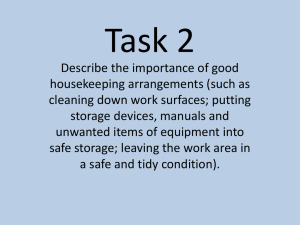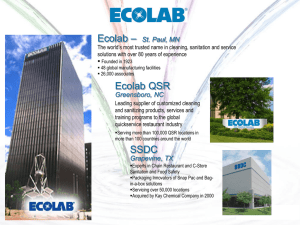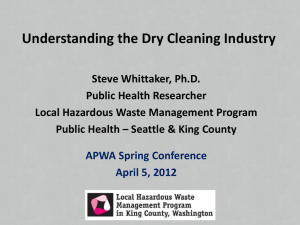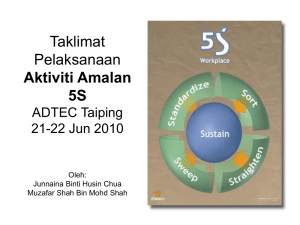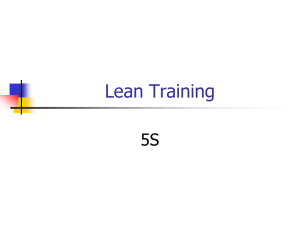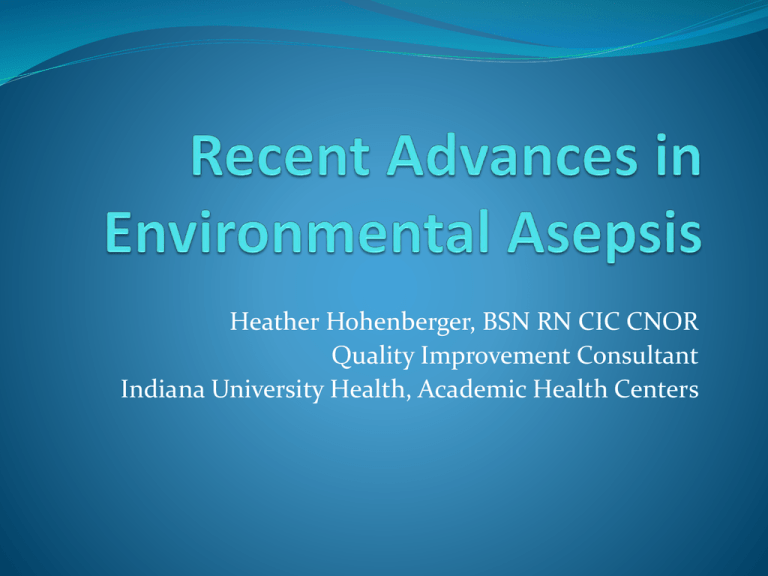
Heather Hohenberger, BSN RN CIC CNOR
Quality Improvement Consultant
Indiana University Health, Academic Health Centers
Conflicts of Interest
The presenter has no conflicts of interest to disclose
Objectives
After attending this course, participants will be able to:
List several recent studies addressing the role that
surfaces play in the transmission of healthcareassociated infections
Identify trends in environmental asepsis in the
procedural environment
Describe new technologies that can be used to routinely
evaluate the quality of environmental hygiene
Additions
Recommendations for cleaning and disinfection in the
Pre/Post operative patient care area
Operating and Procedure Rooms
Sterile Processing areas
Enhanced cleaning recommendations for multi-drug
resistant organisms
Quality and process improvement recommendations
for evaluation of thoroughness in all applicable areas
Multidisciplinary Approach
Strong recommendation for collaboration between
Infection Prevention, Environmental Services, and
organizational leadership regarding
Selection of cleaning chemicals
Selection of cleaning materials, tools, and equipment
Establishment of cleaning frequencies
When enhanced environmental cleaning procedures
should occur
Personnel responsible for cleaning patient care areas
and equipment
Cleaning Chemicals
Environmental protection agency (EPA) registered
hospital-grade disinfectants should be used on
environmental surfaces and equipment
Surfaces should be cleaned with a detergent prior to
disinfection
Disinfectants should be applied and reapplied as
needed to ensure proper dwell time
Spray and misting methods should not be used to
apply cleaning chemicals in procedural areas
Regulations
Safety data sheets must be available and reviewed
Follow manufacturer’s instructions for use along with
local, state, and federal regulations for the
preparation, handling, storage, and disposal of all
chemicals
If the cleaning chemical is removed from the original
container, ensure the secondary container is labeled
with the chemical name, concentration, and
expiration date
Patient Safety
Assess the environment frequently for cleanliness
Floors should always be considered contaminated
Protective barrier coverings should be used to cover
surfaces if the surface cannot withstand disinfection or
is difficult to clean
Equipment should be cleaned and disinfected before
being brought into the patient care area
All patient positioning equipment should have a
moisture-resistant and intact covering
Patient Safety
A clean environment should be reestablished after the
patient is transferred from the patient care area
Procedural areas should be terminally cleaned
An established schedule should be determined for
terminal cleaning
Staff Safety
All personnel should take precautionary measures to
limit transmission of microorganisms when
performing environmental cleaning and handling of
waste materials
Appropriate personal protective equipment (PPE) use
Education Requirements
All personnel should receive initial and ongoing
education and competency verification on their
understanding of the principles and the performance
of the processes for environmental cleaning
Cleaning / disinfection products available
PPE requirements for chemical use
Reconstitution ratios (if applicable)
Product expiration parameters
Storage, handling, and disposal requirements
Safety data sheet location
Cleaning Policies
Policies and procedures for environmental cleaning
processes and practices should be developed, reviewed
periodically, revised as necessary, and readily available
in the practice setting
Quality Assurance
Personnel should participate in quality assurance and
performance improvement activities consistent with
the facility’s plan to improve understanding of and
compliance with the principles and processes of
environmental cleaning
Ongoing feedback can show if problems are
improving, stabilizing, or worsening
Obtaining data from quality assurance or performance
improvement tools can
tell if benchmark goals are met
identify areas where additional help is needed
Process Monitoring
Process monitoring is a necessary part of every
facility’s environmental cleaning program
Process monitoring must include
compliance with regulatory standards
review of products and manufacturers’ instructions for
use
cleaning procedures
monitoring cleaning and disinfection practices
reporting and investigation of adverse events
outbreaks, product issues, corrective actions, evaluation
How should cleanliness be
measured?
Thoroughness of cleaning is the focus of performance
improvement
Measure cleaning practices
visual observation of the cleaning process
visual inspection of cleanliness
fluorescent marking
ATP monitoring
cultures
AORN Environmental Cleaning toolkit
Purpose
educate all team members about the recommended
practices on cleaning the perioperative environment
promote patient safety
prevent the spread of infection in the perioperative
environment
Available at
http://www.aorn.org/Clinical_Practice/ToolKits/Environm
ental_Cleaning_Tool_Kit/Environmental_Cleaning_Tool_K
it.aspx
AORN Environmental Cleaning toolkit
Resources
Modules – Power Point presentations used for
orientation, review, annual competencies
Checklists – Specific for each practice setting, the
cleaning checklists can be used for documentation and
education
Posters – Helpful tools for quick reminders when
providing targeted education for staff
Toolkit Modules
Module 1 - Environmental Cleaning: Basics
Module 2 - Environmental Cleaning: Preoperative and
Postoperative Areas
Module 3 - Environmental Cleaning: OR and
Procedure Rooms
Module 4 - Environmental Cleaning: Sterile
Processing Areas
Module 5 - Special Cleaning Procedures
Module 6 - Quality and Process Improvement
End of Procedure Cleaning
in the OR or Procedural Room
Adapted with permission from Perioperative Standards and Recommended Practices. Copyright © 2014, AORN, Inc, 2170 S. Parker Road, Suite 400, Denver,
CO 80231. All rights reserved.
Terminal Cleaning in the Preoperative
and Postoperative Care Area
Adapted with permission from Perioperative Standards and Recommended Practices. Copyright © 2014, AORN, Inc, 2170 S. Parker Road, Suite 400,
Denver, CO 80231. All rights reserved.
What should be cleaned first?
Clean from
top to bottom
clean to dirty areas
Clockwise or counter-clockwise cleaning may be
performed when used along with clean-to-dirty and
top-to-bottom cleaning methods
Cleaning
Sample Cleaning Checklist
Pre/Post Procedural Areas
Pre- and Postoperative Areas
Cleaning Checklist—Patient Discharge
1.
Patient monitors
1.
Patient beds
1.
Over-bed tables
1.
Television remote
1.
Call lights
1.
Mobile and fixed equipment
a.
Suction equipment
a.
Medical gas regulators
a.
Imaging monitors
a.
Radiology equipment
a.
Warming equipment
1.
Floors and wall if soiled or potentially soiled (eg, splash, splatter, or spray).
1.
Patient transport vehicles including the straps, handles, side rails, and attachments should
be cleaned and disinfected after each patient use.
Completed
Chain of Infection
Microorganism
Susceptible
Host
Reservoir
Portal of Entry
Portal of Exit
Means of
Transmission
Hand Hygiene
Hand hygiene must always be performed
when you remove PPE
as soon as possible after hands are soiled
Hot Topics
One-step vs. Two-step cleaning / disinfecting
ATP testing / Fluorescent marking
Ultraviolet / Solar disinfection
Copper / Silver containing disinfectants
Cleaning / Disinfection
Clean
The absence of visible dust, soil, debris, blood, or other
potentially infectious material
The “first step”
Disinfection
A process that kills most forms of microorganisms on
inanimate surfaces
The “second step”
One-step verses Two-step
One-step product – combines detergent and
disinfectant, typically packaged as single-use wipes
Two-step products – separate detergent and
disinfectant, requires user to perform cleaning and
disinfection in two separate steps
*Products shown are for demonstration only
One-step Wipes
Various terminology used by wipe manufacturers
make it difficult to choose which wipe will best fit the
organizations needs
Sanitizing
Disinfectant
Germicidal
Sporicidal
Virucidal
Antibacterial
*Products shown are for demonstration only
Disinfectant Wipes
While wipes have gained tremendous popularity, there
is poor evidence to support efficacy at the point of care
Effectiveness of the wipe depends on…
Detergency – ability to remove dirt on a visibly soiled
surface
Wetness – ability to leave a layer of disinfectant on the
surface of objects / equipment
Disinfectant efficacy – once the surface is dry
disinfection stops, if residue is left behind there is no
further antimicrobial effect
Wipe it Out
Royal College of Nursing produced “The Selection and
Use of Disinfectant Wipes”
Ultimate resource for thorough understanding of
benefits and limitations of one-step wipe products
Available at
http://www.rcn.org.uk/__data/assets/pdf_file/0011/38
2538/003873.pdf
Infection Control Resources
“Proper Use of Healthcare Disinfectants: The Implications
Associated with Off-Label Use of Disinfectants”
Available at
http://www.infectioncontroltoday.com/webinars/2012/09/pro
per-use-of-healthcare-disinfectants.aspx
“Infection Control Facts: How to Select an Ideal
Disinfectant”
Available at
http://view.officeapps.live.com/op/view.aspx?src=http%3A%2
F%2Fwww.csao.net%2Ffiles%2Fppt%2FHow%2520to%2520S
elect%2520an%2520Ideal%2520Disinfectant.ppt
ATP testing vs. Fluorescent marking
CDC recommends all facilities develop programs to
evaluate the thoroughness of high-touch object
cleaning
Emerging technologies take evaluation of cleaning and
disinfecting beyond direct observation and checklists
Subjective evidence verses objective evidence
Objective Methods for Evaluation
Direct practice observation
Swab cultures or agar slide cultures
ATP bioluminescence
Fluorescent markers
ATP Testing
Measurement of adenosine triphosphate (ATP) on
surfaces using a luciferase assay and luminometer
Method
Before room cleaning / disinfection occurs, a specialized
swab obtains a sample from the surface area or object
The swab is placed in the portable hand-held
luminometer which identifies the amount of ATP in the
sample
After cleaning / disinfection has occurred, the items are
swabbed and analyzed again
ATP Testing
Advantages
Easy to use
Immediate teaching and feedback
Disadvantages
Results vary between systems
A threshold value has not been determined in the healthcare
setting for determining clean / contaminated
Significant amount of ATP in the environment is nonmicrobiological
Bleach based disinfectants alter the bioluminescence reaction
Viruses and bacterial spores do not contain ATP
Fluorescent Marking
Fluorescent powder, gel, or lotion can be used to mark
objects prior to cleaning
Method
Objects are marked before cleaning occurs
Evaluation occurs by shining a UV (black) light over the
object to see if the product has been removed
Fluorescent Marking
Advantages
Ease of use
Immediate teaching and feedback
Disadvantages
Some markers can be seen after the mark is applied,
alerting the individual to clean the tagged object more
thoroughly
Some marking products can be difficult to remove from
surfaces and equipment, leaving permanent stains
Comparison
Method
Ease of Use
Identifies
Pathogens
Useful for
Teaching
Directly
Evaluates
Cleaning
Direct
Observation
Low
No
Yes
Yes
Swab cultures
High
Yes
Unknown
Not
determined
Agar cultures
Good
Limited
Unknown
Not
determined
ATP
High
No
Yes
Not
determined
Fluorescent
marking
High
No
Yes
Yes
Comparing ATP Monitoring Units
Article on ISSA Web site “Using an ATP Monitoring
System in Healthcare Settings”
Representatives from each major industry provider of
ATP monitoring systems in healthcare contributed
their perspective of ATP integration into practice
Available at
http://www.fmlink.com/article.cgi?type=Magazine&ti
tle=Using+an+ATP+Monitoring+System+in+Health+C
are+Settings&pub=ISSA+Today&id=41190&mode=sour
ce
Current Research - ATP
Sciortino, C.V., & Giles, R.A. (2012). Validation and
comparison of three adenosine triphosphate
luminometers for monitoring hospital surface
sanitization: A Rosetta Stone for adenosine
triphosphate testing. American Journal of Infection
Control, 40(8), pp. e233.
Validation occurred for all three meters tested, but
only one could be verified due to variations in system
performance between units
Recommends careful consideration of technologic
application in the healthcare environment
Current Research – Marking
Presentation at the International Conference on
Healthcare-Associated Infections (2010) by Rupp,
M.E., Adler, A, Schellen, M., Cassling. K., Lyden, E.,
Fitzgerald, T., Sholtz, L., & Carling, P. “Hospital-wide
Assessment of Patient Room Environmental
Cleanliness”
With the use of fluorescent marking, 10 high-touch
surfaces were evaluated for cleaning efficacy
74% of high-touch surfaces were adequately cleaned
Several studies have shown us two certainties…
Cleaning practices are often subpar
Improvements made through education and feedback
do not last
This leads us to reach out for new technologies that
can be applied to the healthcare environment
Ultraviolet vs. Hydrogen peroxide
Manual cleaning / disinfection relies on the individual
to follow manufacturer’s stated contact time and
appropriate distribution of the chemical across
surfaces
Even with vigorous cleaning, multidrug resistant
organisms (MDROs) can remain in the environment
for months
Both methods have published evidence of reduction of
contamination in the healthcare setting
Ultraviolet Light
Acts by breaking down the molecular bonds of DNA,
causing cell destruction
Requires appropriate intensity, exposure time, air
movement, and bulb strength
Can be used as an adjunct to manual cleaning /
disinfecting practices
Hydrogen peroxide
Acts by releasing the oxygen (oxidizing) from within
the cell membrane of organisms, leading to cell death
Available as a vapor, aerosolized dry mist, and
vaporized hydrogen peroxide
Active against bacteria, fungus, viruses, and spores
Numerous systems available in various price ranges
Can be used as an adjunct to manual cleaning /
disinfecting practices
Comparison
Method
Advantages
Disadvantages
UV light
• Effective against a wide • Expense
range of organisms
• Requires furniture
• Ease of use
movement
• No need to seal off air • Must be placed in
supply
middle of the room
• Use in unoccupied
room only
Hydrogen peroxide
• Effective against a wide
range of pathogens
• More effective than
manual disinfection
• No toxic by-products
• Disinfection of
complex equipment
• Room must be
unoccupied
• Requires sealing room
and air supply
• Time
• Logistical issues
Current Research – UV light
Rutala, W., Gergen, M., & Weber, D. (2010). Room
decontamination with UV radiation. Infection Control
& Hospital Epidemiology, 31(10), pp. 1025-1028.
Boyce, J., Havill, N., & Moore, B. (2011). Terminal
decontamination of patient rooms using an automated
mobile UV light unit. Infection Control & Hospital
Epidemiology, 32(8), pp. 737-742.
Both studies showed significant reduction of
organisms despite high levels of contamination,
including C diff spores
Current Research – Hydrogen peroxide
Falagas, M., Thomaidis, P., & Kotsantis, K. (2012).
Airborne hydrogen peroxide for disinfection of the
hospital environment for infection control: A
systematic review. Journal of Hospital Infections, 78(3),
pp. 171-177.
Study shows vapor or dry mist distribution of
hydrogen peroxide can effectively disinfect the hospital
environment
Copper
Acts by altering the structure of proteins, leaving them
unable to perform their natural functions (inactive)
Used in self-disinfecting surfaces
Not a cleaning / disinfection strategy, rather this is a
proactive approach to decreasing microbial load
Silver Containing Disinfectants
Action is not entirely understood, but believed to have
a germicidal effect on some bacteria, viruses, algae,
and fungi
Not toxic to humans
Testing and standardization is difficult in the
healthcare setting
Used in self-disinfecting surfaces
Not a cleaning / disinfection strategy, rather this is a
proactive approach to decreasing microbial load
Comparison
Method
Advantages
Disadvantages
Copper
• Not user dependent
• Continuous action
•
•
•
•
Silver
• Not user dependent
• Continuous action
• No studies in the
healthcare environment
Corrosion
Can irritate skin
Expense
Few studies available for
result validation
Current Research – Copper
Karpanen, T., Casey, A., & Lambert, P. (2012). The
antimicrobial efficacy of copper alloy furnishing in the
clinical environment: A crossover study. Infection
Control and Epidemiology, 33(1), pp. 3-9.
Study found a reduction in organisms in the
healthcare environment with the use of copper alloy
materials
However, the items must contain greater than 58%
copper
Healthcare Cleaning “Bundles”
Havill, N.L., (2013) “Best practices in disinfection of
noncritical surfaces in the health care setting: Creating
a bundle for success” American Journal of Infection
Control, 41(5), supplement, pp. S26-S30.
Steps include
Creating policies and procedures
Selection of cleaning products
Determining method of application
Education
Monitoring
Providing feedback
References
AORN Recommended Practices for Environmental
Cleaning (2013).
AORN Environmental Cleaning toolkit (2014).
Association for the Healthcare Environment of the
American Hospital Association. (2012) Practice
Guidance for Healthcare Environmental Cleaning (2nd
Ed.)
Royal College of Nursing. (2011) Wipe it out; One
chance to get it right.
Questions?
Contact Information
Heather Hohenberger, BSN RN CIC CNOR
Quality Improvement Coordinator
Indiana University Health, Academic Health Centers
(317) 963-1344 – office
hhohenberger@iuhealth.org



